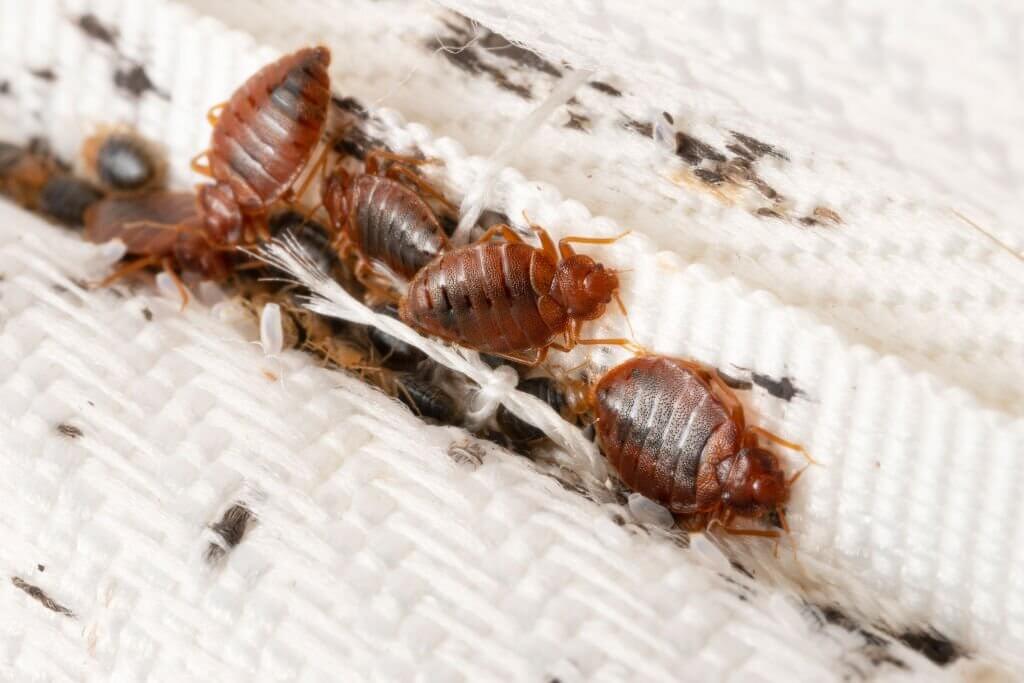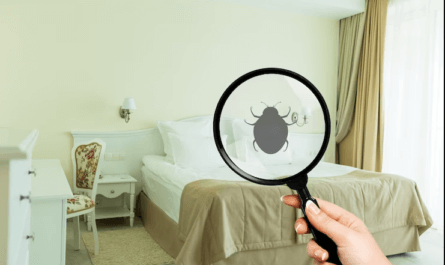The presence of bed bugs in homes can be terrifying, but it’s important to know the facts. Bed bugs do not have wings so they are unable to fly or jump around from person to person or surface-to-surface.
In this blog post, we will explain why bed bugs don’t have wings, how they move and find hosts, what their bites look like and how to identify an infestation. Let’s dive into the fascinating world of beg bugs and learn more about them!
Bed Bug Characteristics and Behavior
Bed bugs are small, flat, wingless insects with an oval shape and brownish color that are active at night while hiding during the day.
Small, flat insects with an oval shape and brownish color
Bed bugs are small, flat insects of an oval shape and a brownish color that can easily be distinguished from other common bugs. Generally, their length ranges between 0.125 inches to just over 0.25 inches and their flattened bodies make them difficult to detect in tight destinations such as cracks and crevices whereas some unfed adults can exhibit a mahogany-colored hue depending on the size and stage of development.
Nymphs which are young bed bugs also typically display a nearly colorless body with only tiny spots or stripes visible providing recognition that adult bedbugs don’t have wings; therefore they are unable to fly or jump.
The distinct characteristics even when presented in different ways both physical signs like dark spots, shed skins and musty odor or invisible signs like bites (painless for some yet cause minor irritation plus allergic reactions for others) enable notifying the presence of these pesky critters effectively.
No wings, unable to fly or jump
Bed bugs have a distinct, oval-shaped body and are typically brownish in color. They may measure between 5 to 7 millimeters in length but can appear even smaller before they feed. This insect has no wings and is unable to fly or jump.

While it does not have functional wings, bed bugs do possess wing pads on their backside that represent their nonfunctional wings which was an adaptation developed due certain environmental factors millions of years ago.
Due to the absence of functioning wings, bed bugs rely heavily upon its six legs for movement and crawling rapidly over surfaces such as floors or fabric furniture in search of hosts from whom they can feed on blood at night.
Without resorting to flight, bed bugs must be carried by humans or other animals via luggage (transmitted known as ‘hitchhiking’) making them easy travelers who spread quickly into new dwellings such as homes, hotel rooms and rented space along with second-hand furniture beds while traveling with unsuspecting persons from place to place undetected until expected red itchy bites occur during sleep.
Nighttime activity and hiding during the day
Bed bugs’ patterns of activity align with being nocturnal: they are most active at night and prefer to hide during the day. Thanks to their small and flat bodies, bed bugs can easily climb into furniture, clothing bags and mattresses found in homes or apartments.
It is here where their preferred environment of darkness and warmth creates an ideal situation for them to feed on human blood after midnight when people are typically asleep. Although a few bed bugs may be caught out during the daylight hours, the majority stick close to their feeding sources instead of wandering far from home – literally!
How Bed Bugs Travel and Find Hosts
Bed bugs have no wings and cannot fly, but they use their flat bodies to hitchhike on items such as luggage or pets in order to enter a home.
Hitchhiking on humans and other animals
Bed bugs are small, flat insects with an oval shape and brownish color incapable of flying or jumping. They typically become active at night when they then look for a source to feed on such as humans or animals.
As good hitchhikers they have the capability to quickly travel into different buildings or even onto public transportation by latching onto clothes, luggage, furniture and other items that you may bring into your home.
The presence of bed bugs can be indicated if there is a musty odor around your beds or areas where people sleep often accompanied by dark spots on sheets/pillows & shed skins left over from molting.
Attracted to body heat and carbon dioxide
Bed bugs don’t have wings and thus, they don’t fly. But this doesn’t mean that they can’t travel from one place to another. These pesky insects are mostly attracted to their hosts through carbon dioxide (CO2) which is produced by humans and animals when they breathe out.
They can also be attracted through body heat as well, making them incredibly good at finding their next meal or home undetected. The combination of these two features means bed bugs can quickly find new hosts, hitchhiking on clothing or items being transported in a suitcase or backpack for instance.
Evidence suggests that bed bug traps may work effectively at catching the pests by mimicking the same combination of smell, body heat and CO2 exhalation given off by human/animal host bodies – luring them into specially designed containers for quick disposal afterwards.
Bed Bug Bites and Effects
Bites can range from painless to causing minor irritation, and in some cases may result in allergic reactions or skin infections.
Bites may be painless or cause minor irritation
Bed bug bites can vary in severity. While some may not have an effect, others may experience redness, itching, and swelling. This depends largely on the individual’s sensitivity level and immune response.
Bed bugs inject a saliva with toxic substances into their host’s skin while feeding which can cause varying reactions depending on the person’s sensitivity levels to these toxins or other allergens associated with bed bugs.
In some cases, people may not even feel them at all as they do not penetrate deep enough into the skin to be registered by nerve endings. It is important to note that certain individuals are more prone to having allergic reactions when bitten which could result in intense itching.
Allergic reactions and skin infections possible
Bed bugs can cause more than discomfort, with potential allergic reactions and skin infections being possible if their bites are not treated properly. Enlarged bite marks are a sign of an allergic reaction to bed bug bites, while painful swellings at the bite site may also occur due to sensitivity.
In rare cases, anaphylaxis—a severe and potentially life-threatening allergic reaction—may arise from extensive bed bug bites. Even without an allergy, irritation will still be present as well as itchiness from the saliva injected into the skin during the biting process – these effects increase risk of infection too.
Secondary bacterial infections can develop when left untreated; this includes ecthyma (which is deep tissue inflammation), cellulitis (bacterial infection under your skin) and lymphangitis (infection of part of a lymphatic vessel).
Oftentimes multiple bed bug bites in one area will result in a red rash or hives where lumps form on your body which could be associated with further health implications for those already suffering allergies or sensitives.
Identifying Bed Bug Infestations
Tell-tale signs of infestation include dark spots on bedding, shed skins, and a musty odor.

Signs of infestation, such as dark spots on bedding, shed skins, and a musty odor
can be indicators of a potential bed bug infestation. Homeowners, renters, landlords, pest control professionals, parents, travelers, people living in urban areas, individuals with allergies or sensitivities, individuals interested in hygiene and cleanliness, second-hand furniture buyers, healthcare facilities, and Airbnb hosts should look out for these signs while trying to identify a possible infestation.
- Dark spots on bedding can indicate a bed bug infestation. These dark spots may look like reddish stains or pinpoint dark spots when viewed up close.
- Unusual odors without any other obvious causes may also indicate a severe bed bug infestation. Musty smells are particularly indicative of bed bugs.
- Bed bug fecal stains and excrement spots are yet another sign of an infestation that cannot be ignored. Fecal stains are dark spots that smear when touched or wetted with alcohol and may also have an unpleasant smell associated with them.
- Shedding skins left behind by bed bugs suggest an active cohort of pests in the area causing the infestation. Shed skins become easier to spot when there are large numbers of them due to the size increase with each molt stage before adulthood has been reached by the insects involved in the infestation.
- If they are found in other rooms aside from your bedroom or bedroom – adjacent spaces further emphasize the possibility of a widespread problem that must be addressed as soon as possible if one hopes to contain it safely at minimal cost and stress levels as soon as possible without spreading contamination further throughout living quarters either domestic or commercial.
Debunking Bed Bug Myths
Common misconceptions need to be addressed, such as the idea that bed bugs can fly or jump, which are both untrue due to their lack of wings and rigid bodies.
Common misconceptions about bed bugs’ ability to fly or jump
Bed bugs are notorious for their ability to spread quickly and cause infestations in homes, businesses, hospitals, hotels, apartments and other areas. Many pests can fly or jump from place to place making them difficult to eliminate.
Fortunately for those dealing with bed bug issues, this isn’t the case since these pests have no wings and are unable to leap like fleas do. They rely on crawling around furniture, baseboards and items left out on counters as a way of traveling between rooms or areas of the home.
The only time bed bugs get a “free pass” is when they hitchhike on clothing or backpacks that allow them access to other parts of the building where they can find new hosts upon whom they may prey.
Dispelling myths about bed bug behavior and prevention
Bed bugs are nocturnal insects that survive by feeding on humans and other animals. Contrary to popular belief, bed bugs can’t fly or jump, they have flat bodies that allow them to hide in tight crevices like mattress seams.
Despite their lack of wings, bed bugs are adept at hitchhiking and will look for skin contact with potential hosts when traveling through spaces such as luggage, clothing items, beds, couches and backpacks.
It’s important to note that some common myths about infestations need to be debunked: Firstly, the presence of eggs or shed skins doesn’t always indicate a present infestation—just an earlier one.
Secondly, these bloodsucking pests can live in any kind of living space regardless of cleanliness – this means second-hand furniture or rentals could still contain bed bug invaders without proper investigation beforehand.




